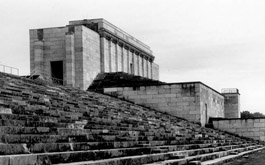
Hitler's buildings in Nuremberg are to be expensively renovated
 |
After years of partial renovations, the complex, designed by Hitler's main architect Albert Speer, needs a total overhaul. Both the 300-meter-long Zeppelin Grandstand, part of which has already had to be closed, and the area for spectators, where the stone seating is overgrown with bushes, are to be saved from decay. "If we don't take action, we might be collecting stones here in a few years," fears Nuremberg City Hall spokesperson Siegfried Zelnhefer.
The site, where the 1934 NSDAP congress was held, captured in Leni Riefenstahl's propaganda film Triumph of the Will, now serves as a memorial. In 2001, a documentation center was established in the local congress hall, which also functions as a museum, memorial, and venue for discussion events. It was created with the joint contribution of an association, the Free State of Bavaria, and the city.
In 2004, Nuremberg City Hall developed a concept to preserve the surrounding buildings for future generations to remember the Nazi dictatorship. On the other hand, moral objections are emerging as to why Nazi structures, which are already partially collapsing, should be reconstructed.
The city should repair the 11 square kilometer area itself but hopes to receive financial support at the federal level as well. "This is not just a Nuremberg issue, but concerns all of Germany," stated Nuremberg Mayor Maly, a Social Democrat (SPD), according to the Süddeutsche Zeitung newspaper.
The remediation of the Zeppelin Field, the congress hall, and the two-kilometer-long street for ceremonial parades has already consumed enormous sums over the decades. After the war, especially in the 40s and 50s, the people of Nuremberg either ignored the site or approached it pragmatically.
As early as the late 1940s, car races were held around the Zeppelin Grandstand. Later, the Rolling Stones and Bob Dylan performed at Zeppelin Field, and a rock festival, Rock im Park, still takes place here every year. "The entire field has been an area of suburban recreation for Nuremberg residents for centuries, long before the Nazis," explains Zelnhefer. The city is pleased that this stage of Hitler's megalomania has not become a pilgrimage site for neo-Nazis. Quite the opposite. "The space has been integrated into the everyday life of Nuremberg's residents," noted the city spokesperson.
Adolf Hitler once realized his dream here: the gigantic grandstand rose like an altar over an enormous space for more than 100,000 people. Flags with swastikas waved as far as the eye could see. A huge swastika was also on the main grandstand, which was blown up by the Americans at the end of World War II.
The English translation is powered by AI tool. Switch to Czech to view the original text source.
0 comments
add comment











